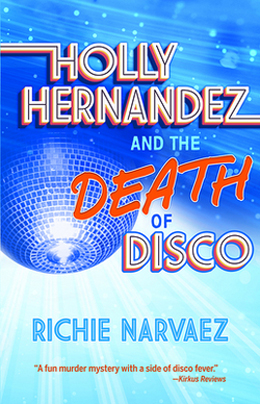For quite some time now, it has been clear that the young adult category has been aching for a traditional mystery series. So much writing in that field represents interesting and ground-breaking blends of multiple genres, that while inspiring, also forgets that the tried-and-true still has value when looked at through a modern lens. Thankfully, Richie Narvaez has come along to release Holly Hernandez and the Death of Disco – a young adult mystery with a conventional plot, set in a historical period, but made modern by populating it with voices that were (and are) too often silenced or ignored.
Holly Hernandez and the Death of Disco is set in New York City in 1979. By placing his narrative at the cusp of a new decade, Richie Narvaez is able to use the dying breaths of the disco era as a metaphor to mirror the coming-of-age of his two main characters. In a similar way to how some of society watched the frivolous dance music of the disco scene morph into music that featured a more dour reflection of reality, it is that clash between the fun-loving past with the seriousness of “maturity” that fuels both Holly and Xander.
Holly Hernandez and Xander Herrera both attend Flatbush Technical High School – and that is about where the similarities end. Holly is a star pupil, while Xander is an awkward loner from the wrong side of the tracks. Their worlds clash when Holly’s mother – a homicide detective – is called in to investigate the death of a teacher. Xander finds himself as a suspect in the murder, while Holly begins as his unknown champion before becoming his investigative rival.

Richie Narvaez employs the commonly used structure of alternating point-of-view narration to unspool this mystery. Both Holly and Xander are investigating the crime, separately but in parallel. This allows readers multiple glimpses of the same scenes and evidence, as well as information that is unique to each teen. It is because they are different people – with different backgrounds and outlooks – that they view the world through their own unique lens. In this way, the author is able to demonstrate how a person’s placement in society alters the way they interact with it; but Narvaez does so in a way that places value on all contributions highlighting many of society’s ills along the way. Remember, the Disco movement was one that celebrated otherness in a way that future generations tried to squash. Holly Hernandez and the Death of Disco is a work that manages to address serious topics like economic disparity, gender stereotypes, racial bias, and a host of other important lessons that if thought about further will help make the reader a better citizen.
Each chapter is titled with a “vocabulary” word. No definition is provided at this point, but the ensuing chapter’s narrative embodies the meaning of that word in a way that allows the reader to understand the concept in far greater depth than simple memorization could achieve. In other words, the reader witnesses how that word’s meaning functions in a real-world situation, which reinforces it in the mind in a way that rote learning is incapable of. An appendix at the conclusion of the novel does provide the official definitions of each word.
Holly Hernandez and the Death of Disco is a delightful read that has more depth and understanding than many of the adult releases coming out of the major publishing conglomerates. This is a book that entertains, first and foremost, but one that also subtly educates along the way. The Latinx perspective is too-often overlooked and needs to be celebrated as representative of society’s voice in the same way as all other minorities. One can only hope that this is not the last time readers see Holly and Xander. Let Holly Hernandez and the Death of Disco be the start of a series, an evolution to the Nancy Drews, Hardy Boys, and Three Investigators of the past into a more inclusive future.
BUY LINKS: Holly Hernandez and the Death of Disco by Richie Narvaez
